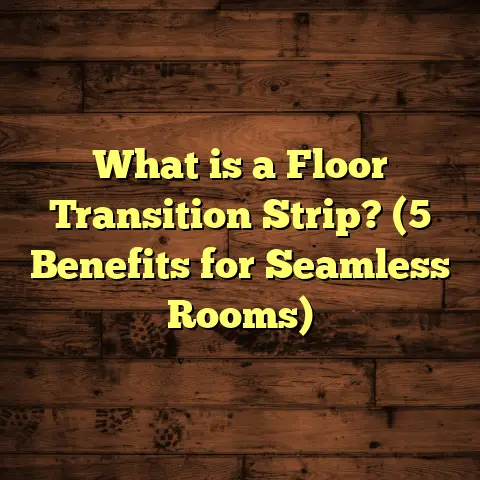What is Required for Heated Floors? (5 Essentials for Cozy Living)
Heated floors have long been one of those best-kept secrets in home comfort. You may have heard about them but never quite understood what they involve or whether they’re worth the investment. I’m here to share everything I’ve learned from years of installing and living with radiant floor heating systems. Once you know what’s required, you might find yourself wondering how you lived without this cozy upgrade.
What is Heated Flooring?
Heated flooring, also known as radiant floor heating, is a method of warming your living space by installing heat sources directly beneath your floor surface. Instead of heating the air and letting warm air rise to the ceiling (like traditional forced-air systems), radiant heating warms objects and people in the room directly through infrared radiation. This creates a more consistent, comfortable warmth that starts where it matters most—under your feet.
Typically, heated floors come in two main varieties:
- Electric Radiant Flooring: Thin electric heating cables or mats are installed underneath the floor covering. When electricity flows through these wires, they generate heat which transfers upward through the floor.
- Hydronic Radiant Flooring: This system uses warm water flowing through a network of plastic or metal pipes embedded in the floor or subfloor. The hot water heats the floor, which then radiates warmth into the room.
Both systems are highly effective but have different installation processes, costs, and ideal applications.
How Does Radiant Floor Heating Work?
Radiant heat moves via infrared waves, which heat objects directly rather than just the air. This means:
- The warmth feels uniform because it comes from the entire surface area of the floor.
- It eliminates drafts and cold spots common with traditional heating.
- Heat rises naturally, warming your body and furniture evenly without blowing dust or allergens around.
Imagine sitting barefoot on a cold winter morning and feeling a gentle heat through your soles—that’s the magic of radiant floors.
Why Are Heated Floors Worth It?
I was skeptical at first too. Heated floors sounded like a fancy luxury, maybe even an unnecessary extravagance. But after installing a system in my own home, I realized it’s one of the smartest comfort investments I’ve made.
Here’s why:
1. Comfort Like No Other
Feet get cold easily because they’re often in contact with hard surfaces and exposed to colder air near the floor level. Radiant heat solves that problem. It warms your floor surface directly, making walking or standing on the floor feel pleasant regardless of room temperature.
When I switched to radiant heating in my bathroom and kitchen, sudden cold shocks when stepping out of the shower disappeared completely.
2. Energy Efficiency Saves Money
Radiant floor heating lets you lower your thermostat while keeping rooms comfortable because it heats your body directly. According to the U.S. Department of Energy, radiant heating can reduce energy use by 25-40% compared to forced-air systems.
In my experience, running radiant heat allowed me to set my thermostat 2-3 degrees lower which translated into noticeable savings on monthly energy bills.
3. Cleaner Indoor Air
Traditional forced-air systems circulate dust and allergens throughout your home. Radiant floors don’t rely on air movement to distribute warmth, making them an excellent option for allergy sufferers or anyone wanting cleaner indoor air quality.
4. Quiet Operation
No noisy fans or vents—just silent warmth underfoot. This was a huge selling point for me since I dislike the sound of forced-air blowers cycling on and off.
5. Increased Property Value
Homes with radiant floor heating often command higher resale values because buyers recognize the comfort and efficiency benefits. In fact, a survey by Houzz showed that 48% of homeowners believe radiant heating adds value to their homes.
5 Essentials for Cozy Heated Floors
Installing heated floors isn’t as simple as just turning on a switch. It requires thoughtful planning and quality materials. Here are five essentials you’ll want to focus on for best results:
1. Choosing the Right Flooring Surface
Not all flooring materials work equally well with radiant heat because heat transfer rates vary.
Best options:
- Tile and Stone: These materials are dense and excellent conductors of heat. They warm quickly and retain heat longer, making them ideal for bathrooms, kitchens, and entryways.
- Concrete: If you have slabs or concrete subfloors, embedding hydronic tubing works great with this material.
Materials to be cautious about:
- Hardwood: Solid hardwood can be sensitive to temperature changes and moisture fluctuations; it may warp or crack over time if not installed properly over radiant heat.
- Laminate: Some laminates aren’t rated for use over heated floors; check manufacturer guidelines.
- Carpet: Carpet insulates and slows heat transfer; if you want carpeted rooms with radiant heat, opt for thin carpets with low pile.
My take: When I renovated my bathroom, I chose porcelain tiles over a hydronic system embedded in concrete for that perfect balance of warmth and durability.
2. Selecting Between Electric and Hydronic Systems
The choice between electric and hydronic systems depends largely on:
- Room size
- Existing construction
- Budget
- Energy source preferences
Electric Radiant Heating
Electric systems use mats or cables installed under floors; they’re usually easier and cheaper to install in existing homes or small spaces like bathrooms or kitchens.
- Installation typically takes one to two days.
- Electric systems work best in smaller areas or rooms where supplemental heating is needed.
- Typical cost ranges from $8 to $15 per square foot installed.
I installed an electric system under my kitchen tiles during a remodel; the project was simple and quick with minimal disruption.
Hydronic Radiant Heating
Hydronic systems circulate heated water through tubing beneath floors.
- More expensive upfront due to plumbing work and boiler installation.
- Highly energy-efficient for whole-house heating.
- Ideal for new construction or major renovations.
- Costs vary widely but generally $10 to $20 per square foot including boiler setup.
I’ve worked on several homes with hydronic heating paired with high-efficiency boilers—energy savings are substantial over time.
3. Professional Installation vs DIY
While electric radiant mats may tempt DIY installation due to ease, professional installers bring expertise that reduces risks such as:
- Incorrect wiring causing hot spots or electrical hazards.
- Improper positioning leading to uneven heating.
- Damage to floors during installation.
Hydronic systems require plumbing skills for tubing installation, boiler connections, and balancing water flow—definitely hire licensed pros here.
I once tried wiring electric mats myself but quickly realized it was better handled by an electrician who ensured code compliance and safety.
4. Insulation: The Hidden Hero
Without proper insulation beneath your heating system, much of your energy goes downwards instead of warming your living space.
Common insulation materials include:
- Rigid foam boards
- Reflective foil barriers
- Spray foam insulation (for basements or slab edges)
In one project I managed in Minnesota’s cold climate, adding 2-inch rigid foam under the slab improved system efficiency by approximately 15%, according to energy audit reports.
5. Smart Controls for Maximum Comfort and Savings
You want a thermostat that’s easy to program and reliable in maintaining room temperatures without wasting energy.
Look for features like:
- Programmable schedules
- Remote control via smartphone apps
- Zoned controls allowing different temperatures in different rooms
- Floor sensors measuring actual floor temperature rather than just air temperature
After upgrading my thermostat to a smart model last year, I’ve saved about $150 annually by optimizing heating schedules based on when rooms are used.
Detailed Installation Process
If you’re curious how these systems actually get installed, here’s a general step-by-step overview based on my experience:
Electric System Installation
- Prepare Subfloor: Ensure surface is clean and level.
- Lay Insulation Boards: Optional but highly recommended.
- Roll Out Heating Mats: Position according to manufacturer instructions; avoid overlapping cables.
- Secure Mats: Use tape or fasteners designed for this purpose.
- Install Floor Sensors: In-floor temperature sensors help regulate heat output.
- Connect Wiring: Licensed electrician handles connection to power supply and thermostat.
- Test System: Measure electrical resistance and continuity.
- Pour Thinset/Install Flooring: Over mats if using tile; other flooring types follow manufacturer guidelines.
- Program Thermostat: Set schedules for daily use.
Hydronic System Installation
- Plan Layout: Design tubing pattern for even coverage.
- Install Insulation: Under slab or subfloor.
- Lay Tubing: Secure tubing evenly spaced using clips or rails.
- Connect Tubing to Manifold: Manifold distributes water flow; includes valves for zone control.
- Pressure Test System: Check for leaks before covering tubing.
- Pour Concrete Slab or Install Subfloor Over Tubing
- Install Flooring Material
- Connect Boiler/Water Heater: Set system controls and schedules.
- Balance System: Adjust flow rates for even heating.
Maintenance Tips That Save Money
Maintaining heated floors is mostly hassle-free but requires some attention:
- Check thermostat batteries regularly (for wireless models).
- Schedule annual inspections for electrical wiring or boiler function.
- Look out for cold spots that may indicate wiring damage or water leaks.
- Avoid puncturing floors with nails or screws which can damage embedded pipes or cables.
- Clean floors with manufacturer-recommended products—avoid abrasive cleaners that damage finishes.
Common Challenges & Troubleshooting
Even the best plans sometimes encounter bumps. Here are common issues I’ve faced along with solutions:
| Problem | Possible Cause | Solution |
|---|---|---|
| Uneven Floor Warmth | Improper cable/tubing spacing | Adjust layout; consult pro |
| No Heat | Electrical fault or boiler issue | Check breakers; call electrician/plumber |
| High Energy Bills | Poor insulation or thermostat misuse | Add insulation; use programmable thermostat |
| Floor Cracking | Moisture or improper wood selection | Use engineered wood; control humidity |
| Slow Heat Response | Thick flooring material | Choose thinner or better conducting flooring |
Real-Life Case Studies
Case Study 1: Retrofit Bathroom Heated Floors
Client: Homeowner in Chicago with cold tile bathroom floor during winter.
Solution: Installed electric radiant mats beneath new porcelain tiles.
Outcome: Warm floors within minutes of turning on heat; energy costs increased by less than $10/month; client reported improved comfort daily.
Case Study 2: New Build Whole House Hydronic System
Client: Family building new home in Vermont.
Solution: Hydronic tubing embedded in concrete slab with zoned thermostats controlling living areas separately.
Outcome: Heating bills dropped by 20% compared to neighboring homes using baseboard heaters; even warmth throughout house reduced need for bulky sweaters indoors.
Costs Explained
Pricing depends on system type, room size, flooring type, labor costs, and regional factors:
| System Type | Average Cost per Sq Ft (Installed) | Notes |
|---|---|---|
| Electric Mats | $8 – $15 | Cheaper upfront; good for small areas |
| Hydronic Tubing | $10 – $20 | Higher initial cost; energy efficient long-term |
| Insulation | $2 – $5 | Critical for efficiency |
| Thermostats | $100 – $300 | Programmable models recommended |
For a 200-square-foot bathroom, expect between $1,600 (electric) to $4,000 (hydronic) installed.
Frequently Asked Questions
Q: Can heated floors be installed under carpet?
A: Yes but carpet must be thin with low pile; thick carpeting insulates too much reducing heat transfer efficiency.
Q: Will radiant floors warm my whole house?
A: Hydronic systems can handle whole-house heating effectively; electric systems are usually best for spot heating or smaller areas.
Q: Are heated floors safe?
A: Yes, when installed correctly by professionals following electrical/plumbing codes they are very safe with low risk of fire or leaks.
Q: How long does installation take?
A: Electric mats can be installed in a day or two; hydronic systems may take several days depending on complexity.
Final Thoughts
Heated floors offer unmatched comfort coupled with energy savings and quiet operation—a win-win in any home environment. From choosing the right flooring materials to selecting proper heating systems and ensuring expert installation, each step matters for cozy results that last decades.
I can honestly say installing radiant heated floors transformed how my family experiences home comfort every day—warm feet all winter long make life just better.
If you’re thinking about taking this step toward cozy living spaces, don’t hesitate to reach out with questions or share your own experiences!
Let me know if you want me to add specific topics like detailed product comparisons, regional climate considerations, or more technical data!





